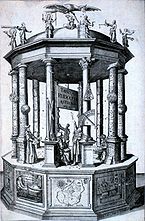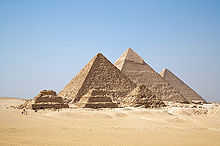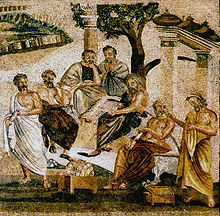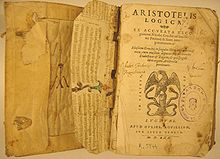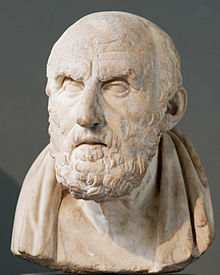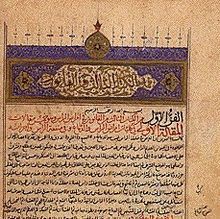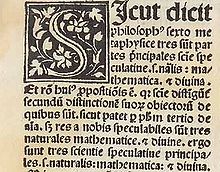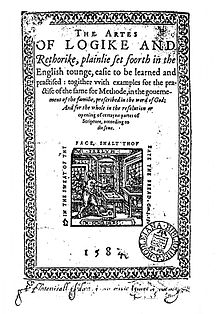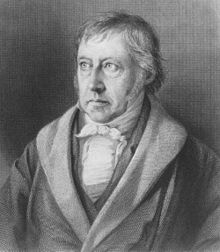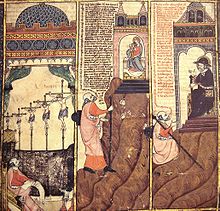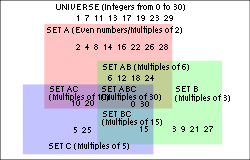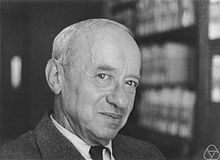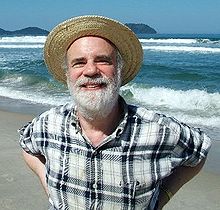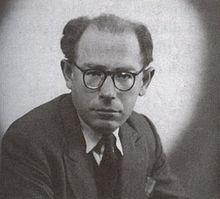- History of logic
-
Philosophy  PhilosophersAestheticians · Epistemologists
PhilosophersAestheticians · Epistemologists
Ethicists · Logicians
Metaphysicians
Social and political philosophersTraditionsErasLiteratureAesthetics · Epistemology
Ethics · Logic · Metaphysics
Political philosophyBranchesPortal History of science BackgroundNatural sciencesAnthropology · Economics · Geography · Linguistics · Political science · Psychology · Sociology · SustainabilityNavigational pagesThe history of logic is the study of the development of the science of valid inference (logic). Formal logic was developed in ancient times in China, India, and Greece. Greek logic, particularly Aristotelian logic, found wide application and acceptance in science and mathematics.
Aristotle's logic was further developed by Islamic and Christian philosophers in the Middle Ages, reaching a high point in the mid-fourteenth century. The period between the fourteenth century and the beginning of the nineteenth century was largely one of decline and neglect, and is regarded as barren by at least one historian of logic.[1]
Logic was revived in the mid-nineteenth century, at the beginning of a revolutionary period when the subject developed into a rigorous and formalistic discipline whose exemplar was the exact method of proof used in mathematics. The development of the modern so-called "symbolic" or "mathematical" logic during this period is the most significant in the two-thousand-year history of logic, and is arguably one of the most important and remarkable events in human intellectual history.[2]
Progress in mathematical logic in the first few decades of the twentieth century, particularly arising from the work of Gödel and Tarski, had a significant impact on analytic philosophy and philosophical logic, particularly from the 1950s onwards, in subjects such as modal logic, temporal logic, deontic logic, and relevance logic.
Contents
Prehistory of logic
Valid reasoning has been employed in all periods of human history. However, logic studies the principles of valid reasoning, inference and demonstration. It is probable that the idea of demonstrating a conclusion first arose in connection with geometry, which originally meant the same as "land measurement".[3] In particular, the ancient Egyptians had empirically discovered some truths of geometry, such as the formula for the volume of a truncated pyramid.[4]
Another origin can be seen in Babylonia. Esagil-kin-apli's medical Diagnostic Handbook in the 11th century BC was based on a logical set of axioms and assumptions,[5] while Babylonian astronomers in the 8th and 7th centuries BC employed an internal logic within their predictive planetary systems, an important contribution to the philosophy of science.[6]
Logic in Greek philosophy
Before Plato
While the ancient Egyptians empirically discovered some truths of geometry, the great achievement of the ancient Greeks was to replace empirical methods by demonstrative science.[4] The systematic study of this seems to have begun with the school of Pythagoras in the late sixth century BC.[4] The three basic principles of geometry are that certain propositions must be accepted as true without demonstration, that all other propositions of the system are derived from these, and that the derivation must be formal, that is, independent of the particular subject matter in question.[4] Fragments of early proofs are preserved in the works of Plato and Aristotle,[7] and the idea of a deductive system was probably known in the Pythagorean school and the Platonic Academy.[4]
Separately from geometry, the idea of a standard argument pattern is found in the Reductio ad absurdum used by Zeno of Elea, a pre-Socratic philosopher of the fifth century BC. This is the technique of drawing an obviously false, absurd or impossible conclusion from an assumption, thus demonstrating that the assumption is false.[8] Plato's Parmenides portrays Zeno as claiming to have written a book defending the monism of Parmenides by demonstrating the absurd consequence of assuming that there is plurality. Other philosophers who practised such dialectic reasoning were the so-called minor Socratics, including Euclid of Megara, who were probably followers of Parmenides and Zeno. The members of this school were called "dialecticians" (from a Greek word meaning "to discuss").
Further evidence that pre-Aristotelian thinkers were concerned with the principles of reasoning is found in the fragment called Dissoi Logoi, probably written at the beginning of the fourth century BC. This is part of a protracted debate about truth and falsity.[9]
Plato's logic
None of the surviving works of the great fourth-century philosopher Plato (428–347) include any formal logic,[10] but they include important contributions to the field of philosophical logic. Plato raises three questions:
- What is it that can properly be called true or false?
- What is the nature of the connection between the assumptions of a valid argument and its conclusion?
- What is the nature of definition?
The first question arises in the dialogue Theaetetus, where Plato identifies thought or opinion with talk or discourse (logos).[11] The second question is a result of Plato's theory of Forms. Forms are not things in the ordinary sense, nor strictly ideas in the mind, but they correspond to what philosophers later called universals, namely an abstract entity common to each set of things that have the same name. In both The Republic and The Sophist, Plato suggests that the necessary connection between the premisses and the conclusion of an argument corresponds to a necessary connection between "forms".[12] The third question is about definition. Many of Plato's dialogues concern the search for a definition of some important concept (justice, truth, the Good), and it is likely that Plato was impressed by the importance of definition in mathematics.[13] What underlies every definition is a Platonic Form, the common nature present in different particular things. Thus a definition reflects the ultimate object of our understanding, and is the foundation of all valid inference. This had a great influence on Aristotle, in particular Aristotle's notion of the essence of a thing, the "what it is to be" a particular thing of a certain kind.[14]
Aristotle's logic
The logic of Aristotle, and particularly his theory of the syllogism, has had an enormous influence in Western thought.[15] His logical works, called the Organon, are the earliest formal study of logic that have come down to modern times. Though it is difficult to determine the dates, the probable order of writing of Aristotle's logical works is:
- The Categories, a study of the ten kinds of primitive term.
- The Topics (with an appendix called On Sophistical Refutations), a discussion of dialectics.
- On Interpretation, an analysis of simple categorical propositions, into simple terms, negation, and signs of quantity; and a comprehensive treatment of the notions of opposition and conversion.
- The Prior Analytics, a formal analysis of valid argument or "syllogism".
- The Posterior Analytics, a study of scientific demonstration, containing Aristotle's mature views on logic.
These works are of outstanding importance in the history of logic. Aristotle was the first logician to attempt a systematic analysis of logical syntax, into noun (or term), and verb. In the Categories, he attempted to classify all the possible things that a term can refer to. This idea underpins his philosophical work, the Metaphysics, which also had a profound influence on Western thought. He was the first to deal with the principles of contradiction and excluded middle in a systematic way. He was the first formal logician (i.e. he gave the principles of reasoning using variables to show the underlying logical form of arguments). He was looking for relations of dependence which characterise necessary inference, and distinguished the validity of these relations, from the truth of the premises (the soundness of the argument). The Prior Analytics contains his exposition of the "syllogistic", where three important principles are applied for the first time in history: the use of variables, a purely formal treatment, and the use of an axiomatic system. In the Topics and Sophistical Refutations he also developed a theory of non-formal logic (e.g. the theory of fallacies).[16]
Stoic logic
The other great school of Greek logic is that of the Stoics.[17] Stoic logic traces its roots back to the late 5th century BC philosopher, Euclid of Megara, a pupil of Socrates and slightly older contemporary of Plato. His pupils and successors were called "Megarians", or "Eristics", and later the "Dialecticians". The two most important dialecticians of the Megarian school were Diodorus Cronus and Philo who were active in the late 4th century BC. The Stoics adopted the Megarian logic and systemized it. The most important member of the school was Chrysippus (c. 278–c. 206 BC), who was its third head, and who formalized much of Stoic doctrine. He is supposed to have written over 700 works, including at least 300 on logic, almost none of which survive.[18] [19] Unlike with Aristotle, we have no complete works by the Megarians or the early Stoics, and have to rely mostly on accounts (sometimes hostile) by later sources, including prominently Diogenes Laertius, Sextus Empiricus, Galen, Aulus Gellius, Alexander of Aphrodisias and Cicero.[20]
Three significant contributions of the Stoic school were (i) their account of modality, (ii) their theory of the Material conditional, and (iii) their account of meaning and truth.[21]
- Modality. According to Aristotle, the Megarians of his day claimed there was no distinction between potentiality and actuality.[22] Diodorus Cronus defined the possible as that which either is or will be, the impossible as what will not be true, and the contingent as that which either is already, or will be false.[23] Diodorus is also famous for his so-called Master argument, that the three propositions "everything that is past is true and necessary", "the impossible does not follow from the possible", and "What neither is nor will be is possible" are inconsistent. Diodorus used the plausibility of the first two to prove that nothing is possible if it neither is nor will be true.[24] Chrysippus, by contrast, denied the second premiss and said that the impossible could follow from the possible.[25]
- Conditional statements. The first logicians to debate conditional statements were Diodorus and his pupil Philo of Megara. Sextus Empiricus refers three times to a debate between Diodorus and Philo. Philo argued that a true conditional is one that does not begin with a truth and end with a falsehood. such as "if it is day, then I am talking". But Diodorus argued that a true conditional is what could not possibly begin with a truth and end with falsehood – thus the conditional quoted above could be false if it were day and I became silent. Philo's criterion of truth is what would now be called a truth-functional definition of "if ... then". In a second reference, Sextus says "According to him there are three ways in which a conditional may be true, and one in which it may be false."[26]
- Meaning and truth. The most important and striking difference between Megarian-Stoic logic and Aristotelian logic is that it concerns propositions, not terms, and is thus closer to modern propositional logic.[27] The Stoics distinguished between utterance (phone) , which may be noise, speech (lexis), which is articulate but which may be meaningless, and discourse (logos), which is meaningful utterance. The most original part of their theory is the idea that what is expressed by a sentence, called a lekton, is something real. This corresponds to what is now called a proposition. Sextus says that according to the Stoics, three things are linked together, that which is signified, that which signifies, and the object. For example, what signifies is the word Dion, what is signified is what Greeks understand but barbarians do not, and the object is Dion himself.[28]
Logic in Asia
Logic in India
Formal logic began independently in ancient India and continued to develop through to early modern times, without any known influence from Greek logic.[29] Medhatithi Gautama (c. 6th century BCE) founded the anviksiki school of logic.[30] The Mahabharata (12.173.45), around the 5th century BCE, refers to the anviksiki and tarka schools of logic. Pāṇini (c. 5th century BCE) developed a form of logic (to which Boolean logic has some similarities) for his formulation of Sanskrit grammar. Logic is described by Chanakya (c. 350-283 BCE) in his Arthashastra as an independent field of inquiry anviksiki.[31]
Two of the six Indian schools of thought deal with logic: Nyaya and Vaisheshika. The Nyaya Sutras of Aksapada Gautama (c. 2nd century CE) constitute the core texts of the Nyaya school, one of the six orthodox schools of Hindu philosophy. This realist school developed a rigid five-member schema of inference involving an initial premise, a reason, an example, an application and a conclusion.[32] The idealist Buddhist philosophy became the chief opponent to the Naiyayikas. Nagarjuna (c. 150-250 CE), the founder of the Madhyamika ("Middle Way") developed an analysis known as the catuskoti (Sanskrit). This four-cornered argumentation systematically examined and rejected the affirmation of a proposition, its denial, the joint affirmation and denial, and finally, the rejection of its affirmation and denial. But it was with Dignaga (c 480-540 CE), who developed a formal syllogistic,[33] and his successor Dharmakirti that Buddhist logic reached its height. Their analysis centered on the definition of necessary logical entailment, "vyapti", also known as invariable concomitance or pervasion.[34] To this end a doctrine known as "apoha" or differentiation was developed.[35] This involved what might be called inclusion and exclusion of defining properties.
The difficulties involved in this enterprise, in part, stimulated the neo-scholastic school of Navya-Nyāya, which developed a formal analysis of inference in the sixteenth century. This later school began around eastern India and Bengal, and developed theories resembling modern logic, such as Gottlob Frege's "distinction between sense and reference of proper names" and his "definition of number," as well as the Navya-Nyaya theory of "restrictive conditions for universals" anticipating some of the developments in modern set theory.[36] Since 1824, Indian logic attracted the attention of many Western scholars, and has had an influence on important 19th-century logicians such as Charles Babbage, Augustus De Morgan, and particularly George Boole, as confirmed by his wife Mary Everest Boole who wrote in an "open letter to Dr Bose" titled "Indian Thought and Western Science in the Nineteenth Century" written in 1901[37][38]: "Think what must have been the effect of the intense Hinduizing of three such men as Babbage, De Morgan and George Boole on the mathematical atmosphere of 1830-1865"
Logic in China
In China, a contemporary of Confucius, Mozi, "Master Mo", is credited with founding the Mohist school, whose canons dealt with issues relating to valid inference and the conditions of correct conclusions. In particular, one of the schools that grew out of Mohism, the Logicians, are credited by some scholars for their early investigation of formal logic. Unfortunately, due to the harsh rule of Legalism in the subsequent Qin Dynasty, this line of investigation disappeared in China until the introduction of Indian philosophy by Buddhists.
Medieval logic
Logic in Islamic philosophy
The works of Al-Farabi, Avicenna, Al-Ghazali, Averroes and other Muslim logicians both criticized and developed Aristotelian logic and were important in communicating the ideas of the ancient world to the medieval West.[39] Al-Farabi (Alfarabi) (873–950) was an Aristotelian logician who discussed the topics of future contingents, the number and relation of the categories, the relation between logic and grammar, and non-Aristotelian forms of inference.[40] Al-Farabi also considered the theories of conditional syllogisms and analogical inference, which were part of the Stoic tradition of logic rather than the Aristotelian.[41]
Ibn Sina (Avicenna) (980–1037) was the founder of Avicennian logic, which replaced Aristotelian logic as the domininant system of logic in the Islamic world,[42] and also had an important influence on Western medieval writers such as Albertus Magnus.[43] Avicenna wrote on the hypothetical syllogism[44] and on the propositional calculus, which were both part of the Stoic logical tradition.[45] He developed an original theory of “temporally modalized” syllogistic[40] and made use of inductive logic, such as the methods of agreement, difference and concomitant variation which are critical to the scientific method.[44] One of Avicenna's ideas had a particularly important influence on Western logicians such as William of Ockham. Avicenna's word for a meaning or notion (ma'na), was translated by the scholastic logicians as the Latin intentio. In medieval logic and epistemology, this is a sign in the mind that naturally represents a thing.[46] This was crucial to the development of Ockham's conceptualism. A universal term (e.g. "man") does not signify a thing existing in reality, but rather a sign in the mind (intentio in intellectu) which represents many things in reality. Ockham cites Avicenna's commentary on Metaphysics V in support of this view.[47]
Fakhr al-Din al-Razi (b. 1149) criticised Aristotle's "first figure" and formulated an early system of inductive logic, foreshadowing the system of inductive logic developed by John Stuart Mill (1806–1873).[48] Al-Razi's work was seen by later Islamic scholars as marking a new direction for Islamic logic, towards a Post-Avicennian logic. This was further elaborated by his student Afdaladdîn al-Khûnajî (d. 1249), who developed a form of logic revolving around the subject matter of conceptions and assents. In response to this tradition, Nasir al-Din al-Tusi (1201–1274) began a tradition of Neo-Avicennian logic which remained faithful to Avicenna's work and existed as an alternative to the more dominant Post-Avicennian school over the following centuries.[49]
Systematic refutations of Greek logic were written by the Illuminationist school, founded by Shahab al-Din Suhrawardi (1155–1191), who developed the idea of "decisive necessity", which refers to the reduction of all modalities (necessity, possibility, contingency and impossibility) to the single mode of necessity.[50] Ibn al-Nafis (1213–1288) wrote a book on Avicennian logic, which was a commentary of Avicenna's Al-Isharat (The Signs) and Al-Hidayah (The Guidance).[51] Another systematic refutation of Greek logic was written by Ibn Taymiyyah (1263–1328), the Ar-Radd 'ala al-Mantiqiyyin (Refutation of Greek Logicians), where he argued against the usefulness, though not the validity, of the syllogism[52] and in favour of inductive reasoning.[48] Ibn Taymiyyah also argued against the certainty of syllogistic arguments and in favour of analogy. His argument is that concepts founded on induction are themselves not certain but only probable, and thus a syllogism based on such concepts is no more certain than an argument based on analogy. He further claimed that induction itself is founded on a process of analogy. His model of analogical reasoning was based on that of juridical arguments.[53][54] This model of analogy has been used in the recent work of John F. Sowa.[54]
The Sharh al-takmil fi'l-mantiq written by Muhammad ibn Fayd Allah ibn Muhammad Amin al-Sharwani in the 15th century is the last major Arabic work on logic that has been studied.[55] However, "thousands upon thousands of pages" on logic were written between the 14th and 19th centuries, though only a fraction of the texts written during this period have been studied by historians, hence little is known about the original work on Islamic logic produced during this later period.[49]
Logic in medieval Europe
"Medieval logic" (also known as "Scholastic logic") generally means the form of Aristotelian logic developed in medieval Europe throughout the period c 1200–1600.[56] For centuries after Stoic logic had been formulated, it was the dominant system of logic in the classical world. When the study of logic resumed after the Dark Ages, the main source was the work of the Christian philosopher Boethius, who was familiar with some of Aristotle's logic, but almost none of the work of the Stoics.[57] Until the twelfth century the only works of Aristotle available in the West were the Categories, On Interpretation and Boethius' translation of the Isagoge of Porphyry (a commentary on the Categories). These works were known as the "Old Logic" (Logica Vetus or Ars Vetus). An important work in this tradition was the Logica Ingredientibus of Peter Abelard (1079–1142). His direct influence was small,[58] but his influence through pupils such as John of Salisbury was great, and his method of applying rigorous logical analysis to theology shaped the way that theological criticism developed in the period that followed.[59]
By the early thirteenth century the remaining works of Aristotle's Organon (including the Prior Analytics, Posterior Analytics and the Sophistical Refutations) had been recovered in the West.[60] Logical work until then was mostly paraphrasis or commentary on the work of Aristotle.[61] The period from the middle of the thirteenth to the middle of the fourteenth century was one of significant developments in logic, particularly in three areas which were original, with little foundation in the Aristotelian tradition that came before. These were:[62]
- The theory of supposition. Supposition theory deals with the way that predicates (e.g. 'man' range over a domain of individuals (e.g. all men).[63] In the proposition 'every man is an animal', does the term 'man' range over or 'supposit for' men existing in the present? Or does the range include past and future men? Can a term supposit for non-existing individuals? Some medievalists have argued that this idea was a precursor of modern first order logic.[64] "The theory of supposition with the associated theories of copulatio (sign-capacity of adjectival terms), ampliatio (widening of referential domain), and distributio constitute one of the most original achievements of Western medieval logic".[65]
- The theory of syncategoremata. Syncategoremata are terms which are necessary for logic, but which, unlike categorematic terms, do not signify on their own behalf, but 'co-signify' with other words. Examples of syncategoremata are 'and', 'not', 'every', 'if', and so on.
- The theory of consequences. A consequence is a hypothetical, conditional proposition: two propositions joined by the terms 'if ... then'. For example 'if a man runs, then God exists' (Si homo currit, Deus est).[66] A fully developed theory of consequences is given in Book III of William of Ockham's work Summa Logicae. There, Ockham distinguishes between 'material' and 'formal' consequences, which are roughly equivalent to the modern material implication and logical implication respectively. Similar accounts are given by Jean Buridan and Albert of Saxony.
The last great works in this tradition are the Logic of John Poinsot (1589–1644, known as John of St Thomas), the Metaphysical Disputations of Francisco Suarez (1548–1617), and the Logica Demonstrativa of Giovanni Girolamo Saccheri (1667–1733).
Traditional logic
The Textbook Tradition
"Traditional Logic" generally means the textbook tradition that begins with Antoine Arnauld and Pierre Nicole's Logic, or the Art of Thinking, better known as the Port-Royal Logic.[67] Published in 1662, it was the most influential work on logic in England until the nineteenth century.[68] The book presents a loosely Cartesian doctrine (that the proposition is a combining of ideas rather than terms, for example) within a framework that is broadly derived from Aristotelian and medieval term logic. Between 1664 and 1700 there were eight editions, and the book had considerable influence after that.[68] The account of propositions that Locke gives in the Essay is essentially that of Port-Royal: "Verbal propositions, which are words, [are] the signs of our ideas, put together or separated in affirmative or negative sentences. So that proposition consists in the putting together or separating these signs, according as the things which they stand for agree or disagree." (Locke, An Essay Concerning Human Understanding, IV. 5. 6)
Another influential work was the Novum Organum by Francis Bacon, published in 1620. The title translates as "new instrument". This is a reference to Aristotle's work Organon. In this work, Bacon rejected the syllogistic method of Aristotle in favour of an alternative procedure "which by slow and faithful toil gathers information from things and brings it into understanding".[69] This method is known as inductive reasoning. The inductive method starts from empirical observation and proceeds to lower axioms or propositions. From the lower axioms more general ones can be derived (by induction). In finding the cause of a phenomenal nature such as heat, one must list all of the situations where heat is found. Then another list should be drawn up, listing situations that are similar to those of the first list except for the lack of heat. A third table lists situations where heat can vary. The form nature, or cause, of heat must be that which is common to all instances in the first table, is lacking from all instances of the second table and varies by degree in instances of the third table.
Other works in the textbook tradition include Isaac Watts' Logick: Or, the Right Use of Reason (1725), Richard Whately's Logic (1826), and John Stuart Mill's A System of Logic (1843). Although the latter was one of the last great works in the tradition, Mill's view that the foundations of logic lay in introspection[70] influenced the view that logic is best understood as a branch of psychology, an approach to the subject which dominated the next fifty years of its development, especially in Germany.[71]
Logic in Hegel's philosophy
G.W.F. Hegel indicated the importance of logic to his philosophical system when he condensed his extensive Science of Logic into a shorter work published in 1817 as the first volume of his Encyclopaedia of the Philosophical Sciences. The "Shorter" or "Encyclopaedia" Logic, as it is often known, lays out a series of transitions which leads from the most empty and abstract of categories – Hegel begins with "Pure Being" and "Pure Nothing" – to the "Absolute" – the category which contains and resolves all the categories which preceded it. Despite the title, Hegel's Logic is not really a contribution to the science of valid inference. Rather than deriving conclusions about concepts through valid inference from premises, Hegel seeks to show that thinking about one concept compels thinking about another concept (one cannot, he argues, possess the concept of "Quality" without the concept of "Quantity"); and the compulsion here is not a matter of individual psychology, but arises almost organically from the content of the concepts themselves. His purpose is to show the rational structure of the "Absolute" – indeed of rationality itself. The method by which thought is driven from one concept to its contrary, and then to further concepts, is known as the Hegelian dialectic.
Although Hegel's Logic has had little impact on mainstream logical studies, its influence can be seen in the work of the British Idealists – for example in F.H. Bradley's Principles of Logic (1883) – and in the economic, political and philosophical studies of Karl Marx and the various schools of Marxism.
Logic and psychology
Between the work of Mill and Frege stretched half a century during which logic was widely treated as a descriptive science, an empirical study of the structure of reasoning, and thus essentially as a branch of psychology.[72] The German psychologist Wilhelm Wundt, for example, discussed deriving "the logical from the psychological laws of thought", emphasizing that "psychological thinking is always the more comprehensive form of thinking."[73] This view was widespread among German philosophers of the period: Theodor Lipps described logic as "a specific discipline of psychology";[74] Christoph von Sigwart understood logical necessity as grounded in the individual's compulsion to think in a certain way;[75] and Benno Erdmann argued that "logical laws only hold within the limits of our thinking"[76] Such was the dominant view of logic in the years following Mill's work.[77] This psychological approach to logic was rejected by Gottlob Frege. It was also subjected to an extended and destructive critique by Edmund Husserl in the first volume of his Logical Investigations (1900), an assault which has been described as "overwhelming".[78] Husserl argued forcefully that grounding logic in psychological observations implied that all logical truths remained unproven, and that skepticism and relativism were unavoidable consequences.
Such criticisms did not immediately extirpate so-called "psychologism". For example, the American philosopher Josiah Royce, while acknowledging the force of Husserl's critique, remained "unable to doubt" that progress in psychology would be accompanied by progress in logic, and vice versa.[79]
Rise of modern logic
The period between the fourteenth century and the beginning of the nineteenth century had been largely one of decline and neglect, and is generally regarded as barren by historians of logic.[1] The revival of logic occurred in the mid-nineteenth century, at the beginning of a revolutionary period where the subject developed into a rigorous and formalistic discipline whose exemplar was the exact method of proof used in mathematics. The development of the modern so-called "symbolic" or "mathematical" logic during this period is the most significant in the 2,000-year history of logic, and is arguably one of the most important and remarkable events in human intellectual history.[2]
A number of features distinguish modern logic from the old Aristotelian or traditional logic, the most important of which are as follows:[80] Modern logic is fundamentally a calculus whose rules of operation are determined only by the shape and not by the meaning of the symbols it employs, as in mathematics. Many logicians were impressed by the "success" of mathematics, in that there has been no prolonged dispute about any properly mathematical result. C.S. Peirce noted[81] that even though a mistake in the evaluation of a definite integral by Laplace led to an error concerning the moon's orbit that persisted for nearly 50 years, the mistake, once spotted, was corrected without any serious dispute. Peirce contrasted this with the disputation and uncertainty surrounding traditional logic, and especially reasoning in metaphysics. He argued that a truly "exact" logic would depend upon mathematical, i.e., "diagrammatic" or "iconic" thought. "Those who follow such methods will ... escape all error except such as will be speedily corrected after it is once suspected". Modern logic is also "constructive" rather than "abstractive"; i.e., rather than abstracting and formalising theorems derived from ordinary language (or from psychological intuitions about validity), it constructs theorems by formal methods, then looks for an interpretation in ordinary language. It is entirely symbolic, meaning that even the logical constants (which the medieval logicians called "syncategoremata") and the categoric terms are expressed in symbols. Finally, modern logic strictly avoids psychological, epistemological and metaphysical questions.[82]
Periods of modern logic
The development of modern logic falls into roughly five periods:[83]
- The embryonic period from Leibniz to 1847, when the notion of a logical calculus was discussed and developed, particularly by Leibniz, but no schools were formed, and isolated periodic attempts were abandoned or went unnoticed.
- The algebraic period from Boole's Analysis to Schröder's Vorlesungen. In this period there were more practitioners, and a greater continuity of development.
- The logicist period from the Begriffsschrift of Frege to the Principia Mathematica of Russell and Whitehead. This was dominated by the "logicist school", whose aim was to incorporate the logic of all mathematical and scientific discourse in a single unified system, and which, taking as a fundamental principle that all mathematical truths are logical, did not accept any non-logical terminology. The major logicists were Frege, Russell, and the early Wittgenstein.[84] It culminates with the Principia, an important work which includes a thorough examination and attempted solution of the antinomies which had been an obstacle to earlier progress.
- The metamathematical period from 1910 to the 1930s, which saw the development of metalogic, in the finitist system of Hilbert, and the non-finitist system of Löwenheim and Skolem, the combination of logic and metalogic in the work of Gödel and Tarski. Gödel's incompleteness theorem of 1931 was one of the greatest achievements in the history of logic. Later in the 1930s Gödel developed the notion of set-theoretic constructibility.
- The period after World War II, when mathematical logic branched into four inter-related but separate areas of research: model theory, proof theory, computability theory, and set theory, and its ideas and methods began to influence philosophy.
Embryonic period
The idea that inference could be represented by a purely mechanical process is found as early as Raymond Lull, who proposed a (somewhat eccentric) method of drawing conclusions by a system of concentric rings. Three hundred years later, the English philosopher and logician Thomas Hobbes suggested that all logic and reasoning could be reduced to the mathematical operations of addition and subtraction.[85] The same idea is found in the work of Leibniz, who had read both Lull and Hobbes, and who argued that logic can be represented through a combinatorial process or calculus. But, like Lull and Hobbes, he failed to develop a detailed or comprehensive system, and his work on this topic was not published until long after his death. Leibniz says that ordinary languages are subject to "countless ambiguities" and are unsuited for a calculus, whose task is to expose mistakes in inference arising from the forms and structures of words;[86] hence, he proposed to identify an alphabet of human thought comprising fundamental concepts which could be composed to express complex ideas,[87] and create a calculus ratiocinator which would make reasoning "as tangible as those of the Mathematicians, so that we can find our error at a glance, and when there are disputes among persons, we can simply say: Let us calculate."[88]
Gergonne (1816) says that reasoning does not have to be about objects about which we have perfectly clear ideas, since algebraic operations can be carried out without our having any idea of the meaning of the symbols involved.[89] Bolzano anticipated a fundamental idea of modern proof theory when he defined logical consequence or "deducibility" in terms of variables: a set of propositions n, o, p ... are deducible from propositions a, b, c ... in respect of the variables i, j, ... if any substitution for i, j that have the effect of making a, b, c ... true, simultaneously make the propositions n, o, p ... also.[90] This is now known as semantic validity.
Algebraic period
Modern logic begins with the so-called "algebraic school", originating with Boole and including Peirce, Jevons, Schröder and Venn.[91] Their objective was to develop a calculus to formalise reasoning in the area of classes, propositions and probabilities. The school begins with Boole's seminal work Mathematical Analysis of Logic which appeared in 1847, although De Morgan (1847) is its immediate precursor.[92] The fundamental idea of Boole's system is that algebraic formulae can be used to express logical relations. This idea occurred to Boole in his teenage years, working as an usher in a private school in Lincoln, Lincolnshire.[93] For example, let x and y stand for classes let the symbol = signify that the classes have the same members, xy stand for the class containing all and only the members of x and y and so on. Boole calls these elective symbols, i.e. symbols which select certain objects for consideration.[94] An expression in which elective symbols are used is called an elective function, and an equation of which the members are elective functions, is an elective equation.[95] The theory of elective functions and their "development" is essentially the modern idea of truth-functions and their expression in disjunctive normal form.[94]
Boole's system admits of two interpretations, in class logic, and propositional logic. Boole distinguished between "primary propositions" which are the subject of syllogistic theory, and "secondary propositions", which are the subject of propositional logic, and showed how under different "interpretations" the same algebraic system could represent both. An example of a primary proposition is "All inhabitants are either Europeans or Asiatics." An example of a secondary proposition is "Either all inhabitants are Europeans or they are all Asiatics."[96] These are easily distinguished in modern propositional calculus, where it is also possible to show that the first follows from the second, but it is a significant disadvantage that there is no way of representing this in the Boolean system.[97]
In his Symbolic Logic (1881), John Venn used diagrams of overlapping areas to express Boolean relations between classes or truth-conditions of propositions. In 1869 Jevons realised that Boole's methods could be mechanised, and constructed a "logical machine" which he showed to the Royal Society the following year.[94] In 1885 Allan Marquand proposed an electrical version of the machine that is still extant (picture at the Firestone Library).
The defects in Boole's system (such as the use of the letter v for existential propositions) were all remedied by his followers. Jevons published Pure Logic, or the Logic of Quality apart from Quantity in 1864, where he suggested a symbol to signify exclusive or, which allowed Boole's system to be greatly simplified.[98] This was usefully exploited by Schröder when he set out theorems in parallel columns in his Vorlesungen (1890–1905). Peirce (1880) showed how all the Boolean elective functions could be expressed by the use of a single primitive binary operation, "neither ... nor ..." and equally well "not both ... and ...",[99] however, like many of Peirce's innovations, this remained unknown or unnoticed until Sheffer rediscovered it in 1913.[100] Boole's early work also lacks the idea of the logical sum which originates in Peirce (1867), Schröder (1877) and Jevons (1890),[101] and the concept of inclusion, first suggested by Gergonne (1816) and clearly articulated by Peirce (1870).
The success of Boole's algebraic system suggested that all logic must be capable of algebraic representation, and there were attempts to express a logic of relations in such form, of which the most ambitious was Schröder's monumental Vorlesungen über die Algebra der Logik ("Lectures on the Algebra of Logic", vol iii 1895), although the original idea was again anticipated by Peirce.[102]
Logicist period
 Frege's "Concept Script"
Frege's "Concept Script"
After Boole, the next great advances were made by the German mathematician Gottlob Frege. Frege's objective was the program of Logicism, i.e. demonstrating that arithmetic is identical with logic.[103] Frege went much further than any of his predecessors in his rigorous and formal approach to logic, and his calculus or Begriffsschrift is important.[103] Frege also tried to show that the concept of number can be defined by purely logical means, so that (if he was right) logic includes arithmetic and all branches of mathematics that are reducible to arithmetic. He was not the first writer to suggest this. In his pioneering work Die Grundlagen der Arithmetik (The Foundations of Arithmetic), sections 15–17, he acknowledges the efforts of Leibniz, J.S. Mill as well as Jevons, citing the latter's claim that "algebra is a highly developed logic, and number but logical discrimination."[104]
Frege's first work, the Begriffsschrift ("concept script") is a rigorously axiomatised system of propositional logic, relying on just two connectives (negational and conditional), two rules of inference (modus ponens and substitution), and six axioms. Frege referred to the "completeness" of this system, but was unable to prove this.[105] The most significant innovation, however, was his explanation of the quantifier in terms of mathematical functions. Traditional logic regards the sentence "Caesar is a man" as of fundamentally the same form as "all men are mortal." Sentences with a proper name subject were regarded as universal in character, interpretable as "every Caesar is a man".[106] Frege argued that the quantifier expression "all men" does not have the same logical or semantic form as "all men", and that the universal proposition "every A is B" is a complex proposition involving two functions, namely ' – is A' and ' – is B' such that whatever satisfies the first, also satisfies the second. In modern notation, this would be expressed as
- (x) Ax -> Bx
In English, "for all x, if Ax then Bx". Thus only singular propositions are of subject-predicate form, and they are irreducibly singular, i.e. not reducible to a general proposition. Universal and particular propositions, by contrast, are not of simple subject-predicate form at all. If "all mammals" were the logical subject of the sentence "all mammals are land-dwellers", then to negate the whole sentence we would have to negate the predicate to give "all mammals are not land-dwellers". But this is not the case.[107] This functional analysis of ordinary-language sentences later had a great impact on philosophy and linguistics.
This means that in Frege's calculus, Boole's "primary" propositions can be represented in a different way from "secondary" propositions. "All inhabitants are either Europeans or Asiatics" is
- (x) [ I(x) -> (E(x) v A(x)) ]
whereas "All the inhabitants are Europeans or all the inhabitants are Asiatics" is
- (x) (I(x) -> E(x)) v (x) (I(x) -> A(x))
As Frege remarked in a critique of Boole's calculus:
- "The real difference is that I avoid [the Boolean] division into two parts ... and give a homogeneous presentation of the lot. In Boole the two parts run alongside one another, so that one is like the mirror image of the other, but for that very reason stands in no organic relation to it'[108]
As well as providing a unified and comprehensive system of logic, Frege's calculus also resolved the ancient problem of multiple generality. The ambiguity of "every girl kissed a boy" is difficult to express in traditional logic, but Frege's logic captures this through the different scope of the quantifiers. Thus
- (x) [ girl(x) -> E(y) (boy(y) & kissed(x,y)) ]
means that to every girl there corresponds some boy (any one will do) who the girl kissed. But
- E(x) [ boy(x) & (y) (girl(y) -> kissed(y,x)) ]
means that there is some particular boy whom every girl kissed. Without this device, the project of logicism would have been doubtful or impossible. Using it, Frege provided a definition of the ancestral relation, of the many-to-one relation, and of mathematical induction.[109]
This period overlaps with the work of the so-called "mathematical school", which included Dedekind, Pasch, Peano, Hilbert, Zermelo, Huntington, Veblen and Heyting. Their objective was the axiomatisation of branches of mathematics like geometry, arithmetic, analysis and set theory.
The logicist project received a near-fatal setback with the discovery of a paradox in 1901 by Bertrand Russell. This proved that the Frege's naive set theory led to a contradiction. Frege's theory is that for any formal criterion, there is a set of all objects that meet the criterion. Russell showed that a set containing exactly the sets that are not members of themselves would contradict its own definition (if it is not a member of itself, it is a member of itself, and if it is a member of itself, it is not).[110] This contradiction is now known as Russell's paradox. One important method of resolving this paradox was proposed by Ernst Zermelo.[111] Zermelo set theory was the first axiomatic set theory. It was developed into the now-canonical Zermelo–Fraenkel set theory (ZF).
The monumental Principia Mathematica, a three-volume work on the foundations of mathematics, written by Russell and Alfred North Whitehead and published 1910–13 also included an attempt to resolve the paradox, by means of an elaborate system of types: a set of elements is of a different type than is each of its elements (set is not the element; one element is not the set) and one cannot speak of the "set of all sets". The Principia was an attempt to derive all mathematical truths from a well-defined set of axioms and inference rules in symbolic logic.
Metamathematical period
The names of Gödel and Tarski dominate the 1930s,[112] a crucial period in the development of metamathematics – the study of mathematics using mathematical methods to produce metatheories, or mathematical theories about other mathematical theories. Early investigations into metamathematics had been driven by Hilbert's program. which sought to resolve the ongoing crisis in the foundations of mathematics by grounding all of mathematics to a finite set of axioms, proving its consistency by "finitistic" means and providing a procedure which would decide the truth or falsity of any mathematical statement. Work on metamathematics culminated in the work of Gödel, who in 1929 showed that a given first-order sentence is deducible if and only if is logically valid – i.e. it is true in every structure for its language. This is known as Gödel's completeness theorem. A year later, he proved two important theorems, which showed Hibert's program to be unattainable in its original form. The first is that no consistent system of axioms whose theorems can be listed by an effective procedure such as an algorithm or computer program is capable of proving all facts about the natural numbers. For any such system, there will always be statements about the natural numbers that are true, but that are unprovable within the system. The second is that if such a system is also capable of proving certain basic facts about the natural numbers, then the system cannot prove the consistency of the system itself. These two results are known as Gödel's incompleteness theorems, or simply Gödel's Theorem. Later in the decade, Gödel developed the concept of set-theoretic constructibility, as part of his proof that the axiom of choice and the continuum hypothesis are consistent with Zermelo-Fraenkel set theory.
In proof theory, Gerhard Gentzen developed natural deduction and the sequent calculus. The former attempts to model logical reasoning as it 'naturally' occurs in practice and is most easily applied to intuitionistic logic, while the latter was devised to clarify the derivation of logical proofs in any formal system. Since Gentzen's work, natural deduction and sequent calculi have been widely applied in the fields of proof theory, mathematical logic and computer science. Gentzen also proved normalization and cut-elimination theorems for intuitionistic and classical logic which could be used to reduce logical proofs to a normal form.[113][114]
Alfred Tarski, a pupil of Łukasiewicz, is best known for his definition of truth and logical consequence, and the semantic concept of logical satisfaction. In 1933, he published (in Polish) The concept of truth in formalized languages, in which he proposed his semantic theory of truth: a sentence such as "snow is white" is true if and only if snow is white. Tarski's theory separated the metalanguage, which makes the statement about truth, from the object language, which contains the sentence whose truth is being asserted, and gave a correspondence (the T-schema) between phrases in the object language and elements of an interpretation. Tarski's approach to the difficult idea of explaining truth has been enduringly influential in logic and philosophy, especially in the development of model theory.[115] Tarski also produced important work on the methodology of deductive systems, and on fundamental principles such as completeness, decidability, consistency and definability. According to Anita Feferman, Tarski "changed the face of logic in the twentieth century".[116]
Alonzo Church and Alan Turing proposed formal models of computability, giving independent negative solutions to Hilbert's Entscheidungsproblem in 1936 and 1937, respectively. The Entscheidungsproblem asked for a procedure that, given any formal mathematical statement, would algorithmically determine whether the statement is true. Church and Turing proved there is no such procedure; Turing's paper introduced the halting problem as a key example of a mathematical problem without an algorithmic solution.
Church's system for computation developed into the modern λ-calculus, while the Turing machine became a standard model for a general-purpose computing device. It was soon shown that many other proposed models of computation were equivalent in power to those proposed by Church and Turing. These results led to the Church–Turing thesis that any deterministic algorithm that can be carried out by a human can be carried out by a Turing machine. Church proved additional undecidability results, showing that both Peano arithmetic and first-order logic are undecidable. Later work by Emil Post and Stephen Cole Kleene in the 1940s extended the scope of computability theory and introduced the concept of degrees of unsolvability.
The results of the first few decades of the twentieth century also had an impact upon analytic philosophy and philosophical logic, particularly from the 1950s onwards, in subjects such as modal logic, temporal logic, deontic logic, and relevance logic.
Logic after WWII
After World War II, mathematical logic branched into four inter-related but separate areas of research: model theory, proof theory, computability theory, and set theory.[117]
In set theory, the method of forcing revolutionized the field by providing a robust method for constructing models and obtaining independence results. Paul Cohen introduced this method in 1962 to prove the independence of the continuum hypothesis and the axiom of choice from Zermelo–Fraenkel set theory.[118] His technique, which was simplified and extended soon after its introduction, has since been applied to many other problems in all areas of mathematical logic.
Computability theory had its roots in the work of Turing, Church, Kleene, and Post in the 1930s and 40s. It developed into a study of abstract computability, which became known as recursion theory.[119] The priority method, discovered independently by Albert Muchnik and Richard Friedberg in the 1950s, led to major advances in the understanding of the degrees of unsolvability and related structures. Research into higher-order computability theory demonstrated its connections to set theory. The fields of constructive analysis and computable analysis were developed to study the effective content of classical mathematical theorems; these in turn inspired the program of reverse mathematics. A separate branch of computability theory, computational complexity theory, was also characterized in logical terms as a result of investigations into descriptive complexity.
Model theory applies the methods of mathematical logic to study models of particular mathematical theories. Alfred Tarski published much pioneering work in the field, which is named after a series of papers he published under the title Contributions to the theory of models. In the 1960s, Abraham Robinson used model-theoretic techniques to develop calculus and analysis based on infinitesimals, a problem that first had been proposed by Leibniz.
In proof theory, the relationship between classical mathematics and intuitionistic mathematics was clarified via tools such as the realizability method invented by Georg Kreisel and Gödel's Dialectica interpretation. This work inspired the contemporary area of proof mining. The Curry-Howard correspondence emerged as a deep analogy between logic and computation, including a correspondence between systems of natural deduction and typed lambda calculi used in computer science. As a result, research into this class of formal systems began to address both logical and computational aspects; this area of research came to be known as modern type theory. Advances were also made in ordinal analysis and the study of independence results in arithmetic such as the Paris–Harrington theorem.
This was also a period, particularly in the 1950s and afterwards, when the ideas of mathematical logic begin to influence philosophical thinking. For example, tense logic is a formalised system for representing, and reasoning about, propositions qualified in terms of time. The philosopher Arthur Prior played a significant role in its development in the 1960s. Modal logics extend the scope of formal logic to include the elements of modality (for example, possibility and necessity). The ideas of Saul Kripke, particularly about possible worlds, and the formal system now called Kripke semantics have had a profound impact on analytic philosophy.[120] His best known and most influential work is Naming and Necessity (1980).[121] Deontic logics are closely related to modal logics: they attempt to capture the logical features of obligation, permission and related concepts. Ernst Mally, a pupil of Alexius Meinong, was the first to propose a formal deontic system in his Grundgesetze des Sollens, based on the syntax of Whitehead's and Russell's propositional calculus. Another logical system founded after World War II was fuzzy logic by Iranian mathematician Lotfi Asker Zadeh in 1965.
See also
Notes
- ^ a b Oxford Companion p. 498; Bochenski, Part I Introduction, passim
- ^ a b Oxford Companion p. 500
- ^ Kneale, p. 2
- ^ a b c d e Kneale p. 3
- ^ H. F. J. Horstmanshoff, Marten Stol, Cornelis Tilburg (2004), Magic and Rationality in Ancient Near Eastern and Graeco-Roman Medicine, p. 99, Brill Publishers, ISBN 9004136665.
- ^ D. Brown (2000), Mesopotamian Planetary Astronomy-Astrology , Styx Publications, ISBN 9056930362.
- ^ Heath, Mathematics in Aristotle, cited in Kneale, p. 5
- ^ Kneale p. 15
- ^ Kneale, p. 16
- ^ Kneale p. 17
- ^ "forming an opinion is talking, and opinion is speech that is held not with someone else or aloud but in silence with oneself" Theaetetus 189E–190A
- ^ Kneale p. 20. For example, the proof given in the Meno that the square on the diagonal is double the area of the original square presumably involves the forms of the square and the triangle, and the necessary relation between them
- ^ Kneale p. 21
- ^ Zalta, Edward N. "Aristotle's Logic". Stanford University, 18 March 2000. Retrieved 13 March 2010.
- ^ See e.g. Aristotle's logic, Stanford Encyclopedia of Philosophy
- ^ Bochenski p. 63
- ^ "Throughout later antiquity two great schools of logic were distinguished, the Peripatetic which was derived from Aristotle, and the Stoic which was developed by Chrysippus from the teachings of the Megarians" – Kneale p. 113
- ^ Oxford Companion, article "Chrysippus", p. 134
- ^ [1] Stanford Encyclopedia of Philosophy: Susanne Bobzien, Ancient Logic
- ^ K. Huelser, Die Fragmente zur Dialektik der Stoiker, 4 vols, Stuttgart 1986-7
- ^ Kneale 117–158
- ^ Metaphysics Eta 3, 1046b 29
- ^ Boethius, Commentary on the Perihermenias, Meiser p. 234
- ^ Epictetus, Dissertationes ed. Schenkel ii. 19. I.
- ^ Alexander p. 177
- ^ Sextus, Adv. Math. pp. viii, 113
- ^ See e.g. Lukasiewicz p. 21
- ^ Sextus pp. viii., 11, 12
- ^ Bochenski p. 446
- ^ S. C. Vidyabhusana (1971). A History of Indian Logic: Ancient, Mediaeval, and Modern Schools.
- ^ R. P. Kangle (1986). The Kautiliya Arthashastra (1.2.11). Motilal Banarsidass.
- ^ Bochenski p. 417 and passim
- ^ Bochenski pp. 431–7
- ^ Bochenski p. 438
- ^ Bochenksi p. 441
- ^ Kisor Kumar Chakrabarti (June 1976). "Some Comparisons Between Frege's Logic and Navya-Nyaya Logic". Philosophy and Phenomenological Research (International Phenomenological Society) 36 (4): 554–563. doi:10.2307/2106873. JSTOR 2106873. "This paper consists of three parts. The first part deals with Frege's distinction between sense and reference of proper names and a similar distinction in Navya-Nyaya logic. In the second part we have compared Frege's definition of number to the Navya-Nyaya definition of number. In the third part we have shown how the study of the so-called 'restrictive conditions for universals' in Navya-Nyaya logic anticipated some of the developments of modern set theory."
- ^ Boole, Mary Everest "Collected Works" eds E M Cobham and E S Dummer London, Daniel 1931. Letter also published in the Ceylon National Review in 1909, and published as a separate pamphlet "The Psychologic Aspect of Imperialism" in 1911.
- ^ Jonardon Ganeri (2001), Indian logic: a reader, Routledge, p. vii, ISBN 0700713069
- ^ See e.g. Routledge Encyclopedia of Philosophy Online Version 2.0, article 'Islamic philosophy'
- ^ a b History of logic: Arabic logic, Encyclopædia Britannica.
- ^ Feldman, Seymour (1964-11-26). "Rescher on Arabic Logic". The Journal of Philosophy (Journal of Philosophy, Inc.) 61 (22): 724–734. doi:10.2307/2023632. ISSN 0022-362X. JSTOR 2023632. [726]. Long, A. A.; D. N. Sedley (1987). The Hellenistic Philosophers. Vol 1: Translations of the principal sources with philosophical commentary. Cambridge: Cambridge University Press. ISBN 0-521-27556-3.
- ^ Dag Nikolaus Hasse (September 19, 2008). "Influence of Arabic and Islamic Philosophy on the Latin West". Stanford Encyclopedia of Philosophy. http://plato.stanford.edu/entries/arabic-islamic-influence/. Retrieved 2009-10-13.
- ^ Richard F. Washell (1973), "Logic, Language, and Albert the Great", Journal of the History of Ideas 34 (3), pp. 445–450 [445].
- ^ a b Goodman, Lenn Evan (2003), Islamic Humanism, p. 155, Oxford University Press, ISBN 0-19-513580-6.
- ^ Goodman, Lenn Evan (1992); Avicenna, p. 188, Routledge, ISBN 0-415-01929-X.
- ^ Kneale p. 229
- ^ Kneale: p. 266; Ockham: Summa Logicae i. 14; Avicenna: Avicennae Opera Venice 1508 f87rb
- ^ a b Muhammad Iqbal, The Reconstruction of Religious Thought in Islam, "The Spirit of Muslim Culture" (cf. [2] and [3])
- ^ a b Tony Street (July 23, 2008). "Arabic and Islamic Philosophy of Language and Logic". Stanford Encyclopedia of Philosophy. http://plato.stanford.edu/entries/arabic-islamic-language. Retrieved 2008-12-05.
- ^ Dr. Lotfollah Nabavi, Sohrevardi's Theory of Decisive Necessity and kripke's QSS System, Journal of Faculty of Literature and Human Sciences.
- ^ Dr. Abu Shadi Al-Roubi (1982), "Ibn Al-Nafis as a philosopher", Symposium on Ibn al-Nafis, Second International Conference on Islamic Medicine: Islamic Medical Organization, Kuwait (cf. Ibn al-Nafis As a Philosopher, Encyclopedia of Islamic World).
- ^ See pp. 253–254 of Street, Tony (2005). "Logic". In Peter Adamson and Richard C. Taylor (edd.). The Cambridge Companion to Arabic Philosophy. Cambridge University Press. pp. 247–265. ISBN 9780521520690.
- ^ Ruth Mas (1998). "Qiyas: A Study in Islamic Logic". Folia Orientalia 34: 113–128. ISSN 0015-5675. http://www.colorado.edu/ReligiousStudies/faculty/mas/LOGIC.pdf.
- ^ a b John F. Sowa; Arun K. Majumdar (2003). "Analogical reasoning". Conceptual Structures for Knowledge Creation and Communication, Proceedings of ICCS 2003. Berlin: Springer-Verlag. http://www.jfsowa.com/pubs/analog.htm., pp. 16-36
- ^ Nicholas Rescher and Arnold vander Nat, "The Arabic Theory of Temporal Modal Syllogistic", in George Fadlo Hourani (1975), Essays on Islamic Philosophy and Science, pp. 189–221, State University of New York Press, ISBN 0-87395-224-3.
- ^ Boehner p. xiv
- ^ Kneale p. 198
- ^ Stephen Dumont, article "Peter Abelard" in Gracia and Noone p. 492
- ^ Kneale, pp. 202–3
- ^ See e.g. Kneale p. 225
- ^ Boehner p. 1
- ^ Boehner pp. 19–76
- ^ Boehner p. 29
- ^ Boehner p. 30
- ^ Ebbesen 1981
- ^ Boehner pp. 54–5
- ^ Oxford Companion p. 504, article "Traditional logic"
- ^ a b Buroker xxiii
- ^ Farrington, 1964, 89
- ^ N. Abbagnano, "Psychologism" in P. Edwards (ed) The Encyclopaedia of Philosophy, MacMillan, 1967
- ^ Of the German literature in this period, Robert Adamson wrote "Logics swarm as bees in springtime..."; Robert Adamson, A Short History of Logic, Wm. Blackwood & Sons, 1911, page 242
- ^ See e.g. Psychologism, Stanford Encyclopedia of Philosophy
- ^ Wilhelm Wundt, Logik (1880–1883); quoted in Edmund Husserl, Logical Investigations, translated J.N. Findlay, Routledge, 2008, Volume 1, pp. 115–116.
- ^ Theodor Lipps, Grundzüge der Logik (1893); quoted in Edmund Husserl, Logical Investigations, translated J.N. Findlay, Routledge, 2008, Volume 1, p. 40
- ^ Christoph von Sigwart, Logik (1873–78); quoted in Edmund Husserl, Logical Investigations, translated J.N. Findlay, Routledge, 2008, Volume 1, p. 51
- ^ Benno Erdmann, Logik (1892); quoted in Edmund Husserl, Logical Investigations, translated J.N. Findlay, Routledge, 2008, Volume 1, p. 96
- ^ Dermot Moran, "Introduction"; Edmund Husserl, Logical Investigations, translated J.N. Findlay, Routledge, 2008, Volume 1, p. xxi
- ^ Michael Dummett, "Preface"; Edmund Husserl, Logical Investigations, translated J.N. Findlay, Routledge, 2008, Volume 1, p. xvii
- ^ Josiah Royce, "Recent Logical Enquiries and their Psychological Bearings" (1902) in John J. McDermott (ed) The Basic Writings of Josiah Royce Volume 2, Fordham University Press, 2005, p. 661
- ^ Bochenski, p. 266
- ^ Peirce 1896
- ^ Bochenski, ibidem
- ^ See Bochenski p. 269
- ^ Oxford Companion p. 499
- ^ El. philos. sect. I de corp 1.1.2.
- ^ Bochenski p. 274
- ^ Rutherford, Donald, 1995, "Philosophy and language" in Jolley, N., ed., The Cambridge Companion to Leibniz. Cambridge Univ. Press.
- ^ Wiener, Philip, 1951. Leibniz: Selections. Scribner.
- ^ Essai de dialectique rationelle, 211n, quoted in Bochenski p. 277.
- ^ Wissenschaftslehre II 198ff, quoted in Bochenski 280; see Oxford 'Companion p. 498.
- ^ See e.g. Bochenski p. 296 and passim
- ^ Before publishing, he wrote to De Morgan, who was just finishing his work Formal Logic. De Morgan suggested they should publish first, and thus the two books appeared at the same time, possibly even reaching the bookshops on the same day. cf. Kneale p. 404
- ^ Kneale p. 404
- ^ a b c Kneale p. 407
- ^ Boole (1847) p. 16
- ^ Boole 1847 pp. 58–9
- ^ Beaney p. 11
- ^ Kneale p. 422
- ^ Peirce, "A Boolean Algebra with One Constant", 1880 MS, Collected Papers v. 4, paragraphs 12–20, reprinted Writings v. 4, pp. 218-21. Google Preview.
- ^ Trans. Amer. Math. Soc., xiv (1913), pp. 481–8. This is now known as the Sheffer stroke
- ^ Bochenski 296
- ^ See CP III
- ^ a b Kneale p. 435
- ^ Jevons, The Principles of Science, London 1879, p. 156, quoted in Grundlagen 15
- ^ Beaney p. 10 – the completeness of Frege's system was eventually proved by Jan Łukasiewicz in 1934
- ^ See for example the argument by the medieval logician William of Ockham that singular propositions are universal, in Summa Logicae III. 8 (??)
- ^ "On concept and object" p. 198; Geach p. 48
- ^ BLC p. 14, quoted in Beaney p. 12
- ^ See e.g. The Internet Encyclopedia of Philosophy, article "Frege"
- ^ See e.g. Potter 2004
- ^ Zermelo 1908
- ^ Feferman 1999 p. 1
- ^ Girard, Jean-Yves; Paul Taylor, Yves Lafont (1990) [1989]. Proofs and Types. Cambridge University Press (Cambridge Tracts in Theoretical Computer Science, 7). ISBN 0-521-37181-3. http://www.paultaylor.eu/stable/Proofs%2BTypes.html.
- ^ Alex Sakharov, "Cut Elimination Theorem" from MathWorld.
- ^ Feferman and Feferman 2004, p. 122, discussing "The Impact of Tarski's Theory of Truth".
- ^ Feferman 1999, p. 1
- ^ See e.g. Barwise, Handbook of Mathematical Logic
- ^ The Independence of the Continuum Hypothesis, II Paul J. Cohen Proceedings of the National Academy of Sciences of the United States of America, Vol. 51, No. 1. (Jan. 15, 1964), pp. 105-110.
- ^ Many of the foundational papers are collected in The Undecidable (1965) edited by Martin Davis
- ^ Jerry Fodor, "Water's water everywhere", London Review of Books, 21 October 2004
- ^ See Philosophical Analysis in the Twentieth Century: Volume 2: The Age of Meaning, Scott Soames: "Naming and Necessity is among the most important works ever, ranking with the classical work of Frege in the late nineteenth century, and of Russell, Tarski and Wittgenstein in the first half of the twentieth century". Cited in Byrne, Alex and Hall, Ned. 2004. 'Necessary Truths'. Boston Review October/November 2004
References
- Alexander of Aphrodisias, In Aristotelis An. Pr. Lib. I Commentarium, ed. Wallies, C.I.A.G.
- Avicenna, Avicennae Opera Venice 1508.
- Barwise, Jon, ed. (1982), Handbook of Mathematical Logic, Studies in Logic and the Foundations of Mathematics, North Holland, ISBN 978-0-444-86388-1 .
- Beaney, Michael, The Frege Reader, London: Blackwell 1997.
- Bochenski, I.M., A History of Formal Logic, Notre Dame press, 1961.
- Philotheus Boehner, Medieval Logic, Manchester 1950.
- Boethius Commentary on the Perihermenias, Secunda Editio, ed. Meiser.
- Bolzano, Bernard Wissenschaftslehre, 4 Bde Neudr., 2. verb, A. hrsg. W. Schultz, Leipzig I-II 1929, III 1930, IV 1931 (trans. as Theory of science, attempt at a detailed and in the main novel exposition of logic with constant attention to earlier authors. (Edited and translated by Rolf George University of California Press, Berkeley and Los Angeles 1972).
- Bolzano, Bernard Theory of science (Edited, with an introduction, by Jan Berg. Translated from the German by Burnham Terrell – D. Reidel Publishing Company, Dordrecht and Boston 1973).
- Boole, George (1847) The Mathematical Analysis of Logic (Cambridge and London); repr. in Studies in Logic and Probability, ed. R. Rhees (London 1952).
- Boole, George (1854) The Laws of Thought (London and Cambridge); repr. as Collected Logical Works. Vol. 2, (Chicago and London: Open Court, 1940).
- Jill Vance Buroker (transl. and introduction), Logic or the Art of Thinking, Cambridge University Press, 1996, ISBN 0521482496.
- Church, Alonzo, 1936-8. "A bibliography of symbolic logic". Journal of Symbolic Logic 1: 121–218; 3:178–212.
- Ebbesen, S. "Early supposition theory (12th–13th Century)" Histoire, Épistémologie, Langage 3/1: 35–48 (1981).
- Epictetus, Dissertationes ed. Schenkl.
- Farrington, B., The Philosophy of Francis Bacon, Liverpool 1964.
- Feferman, Anita B. (1999). "Alfred Tarski". American National Biography. 21. Oxford University Press. pp. 330–332. ISBN 9780195128000.
- Feferman, Anita B.; Feferman, Solomon (2004). Alfred Tarski: Life and Logic. Cambridge University Press. ISBN 9780521802406. OCLC 54691904.
- Frege, G., Boole's Logical Calculus and the Concept Script, 1882, in Posthumous Writings transl. P.Long and R. White 1969, pp. 9–46.
- Gabbay, Dov and John Woods, eds, Handbook of the History of Logic 2004. 1. Greek, Indian and Arabic logic; 2. Mediaeval and Renaissance logic; 3. The rise of modern logic: from Leibniz to Frege; 4. British logic in the Nineteenth century; 5. Logic from Russell to Church; 6. Sets and extensions in the Twentieth century (not yet published); 7. Logic and the modalities in the Twentieth century; 8. The many-valued and nonmonotonic turn in logic; 9. Logic and computation (not yet published); 10. Inductive logic (not yet published); 11. Logic: A history of its central concepts (not yet published) Elsevier, ISBN 0-444-51611-5.
- Geach, P.T. Logic Matters, Blackwell 1972.
- Gergonne, Joseph Diaz, (1816) "Essai de dialectique rationelle", in Annales de mathem, pures et appl. 7, 1816/7, 189–228.
- Goodman, Lenn Evan (2003). Islamic Humanism. Oxford University Press, ISBN 0-19-513580-6.
- Goodman, Lenn Evan (1992). Avicenna. Routledge, ISBN 0-415-01929-X.
- Grattan-Guinness, Ivor, 2000. The Search for Mathematical Roots 1870–1940. Princeton University Press.
- Gracia, J.G. and Noone, T.B., A Companion to Philosophy in the Middle Ages, London 2003.
- Haaparanta, Leila (ed.) 2009. The Development of Modern Logic Oxford University Press.
- Heath, T.L., 1949. Mathematics in Aristotle Oxford University Press.
- Heath, T.L., 1931, A Manual of Greek Mathematics, Oxford (Clarendon Press).
- Honderich, Ted (ed.). The Oxford Companion to Philosophy (New York: Oxford University Press, 1995) ISBN 0-19-866132-0.
- Jevons, The Principles of Science, London 1879.
- Kneale, William and Martha, 1962. The development of logic. Oxford University Press, ISBN 0-19-824773-7.
- Lukasiewicz, Aristotle's Syllogistic, Oxford University Press 1951.
- Ockham's Theory of Terms: Part I of the Summa Logicae, translated and introduced by Michael J. Loux (Notre Dame, IN: University of Notre Dame Press 1974). Reprinted: South Bend, IN: St. Augustine's Press, 1998.
- Ockham's Theory of Propositions: Part II of the Summa Logicae, translated by Alfred J. Freddoso and Henry Schuurman and introduced by Alfred J. Freddoso (Notre Dame, IN: University of Notre Dame Press, 1980). Reprinted: South Bend, IN: St. Augustine's Press, 1998.
- Peirce, C.S., (1896), "The Regenerated Logic", The Monist, vol. VII, No. 1, p pp. 19-40, The Open Court Publishing Co., Chicago, IL, 1896, for the Hegeler Institute. Reprinted (CP 3.425–455). Internet Archive The Monist 7.
- Michael Potter (2004), Set Theory and its Philosophy, Oxford Univ. Press.
- Sextus Empiricus, Against the Grammarians (Adversos Mathematicos I). David Blank (trans.) (Oxford: Clarendon Press, 1998). ISBN 0-19-824470-3.
- Zermelo, Ernst (1908). "Untersuchungen über die Grundlagen der Mengenlehre I". Mathematische Annalen 65: 261–281. doi:10.1007/BF01449999. English translation in Heijenoort, Jean van (1967). "Investigations in the foundations of set theory". From Frege to Gödel: A Source Book in Mathematical Logic, 1879–1931. Source Books in the History of the Sciences. Harvard Univ. Press. pp. 199–215. ISBN 978-0674324497..
External links
- History of Logic in Relationship to Ontology Annotated bibliography on the history of logic
- Peter of Spain entry by Joke Spruyt in the Stanford Encyclopedia of Philosophy
- Paul Spade's "Thoughts Words and Things"
- John of St Thomas
Categories:
Wikimedia Foundation. 2010.

